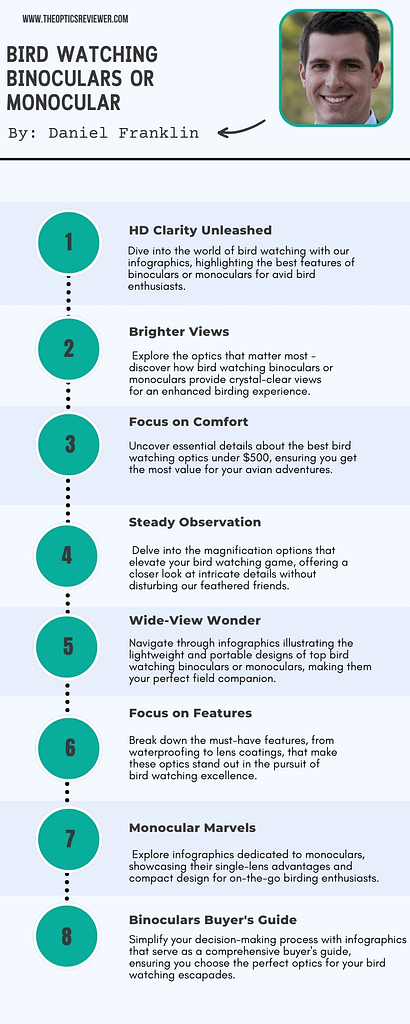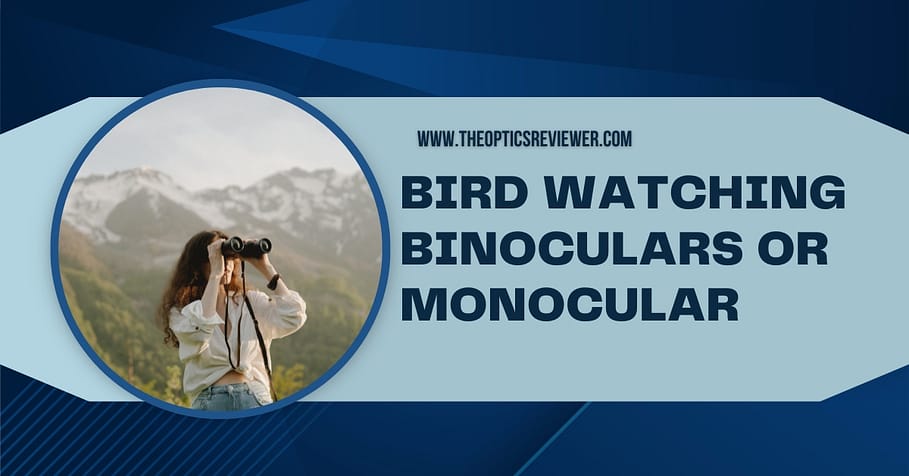Embarking on a journey into the captivating world of birdwatching requires more than just enthusiasm – it demands precision and clarity to capture every fluttering detail. That’s where the magic of Bird Watching Binoculars or Monocular comes into play. Welcome to a realm where nature enthusiasts, ornithologists, and curious souls converge to witness avian wonders in exquisite detail.
In this immersive guide, we delve into the art of birdwatching optics, exploring the unique features and advantages of both binoculars and monoculars. Whether you’re a seasoned birder or a budding naturalist, choosing the right tool can make the difference between a fleeting glimpse and an unforgettable encounter. Join us as we unfold the possibilities, unlocking a closer connection to the avian realm through the lens of Bird Watching Binoculars or Monocular. It’s time to elevate your birdwatching experience and embrace the world of avifauna with unparalleled clarity.
Contents
- 1 Key Highlights
- 2 What is Meant By Monoculars and Binoculars For Bird Watching?
- 3 Bird Watching Binoculars or Monocular – Key Differences
- 4 What are the Differences in Image Quality Between Monoculars and Binoculars?
- 5 Pros and Cons of Using Binoculars For Bird Watching
- 6 Pros and Cons of Using Monoculars For Bird Watching
- 7 Conclusion
- 8 References
- 9 Frequently Asked Questions
- 9.1 Can Monoculars Be Used for Other Activities Besides Bird Watching?
- 9.2 Are There Any Specific Features to Look for in Bird Watching Binoculars or Monoculars for Eyeglass Wearers?
- 9.3 Can Monoculars Provide the Same Level of Depth Perception as Binoculars for Bird Watching?
- 9.4 Do Bird Watching Binoculars or Monoculars Come With Image Stabilization Technology?
- 9.5 Are There Any Specific Cleaning or Maintenance Tips for Bird Watching Binoculars or Monoculars to Ensure Longevity and Optimal Performance?
Key Highlights
- Binoculars offer superior image clarity and magnification, ideal for detailed bird observation.
- Monoculars are more compact and portable, suitable for travelers or those prioritizing convenience.
- Consider individual preferences and needs when choosing between binoculars and monoculars for bird watching.
- Factors like size, portability, cost, and image quality play a role in selecting the right optic.
What is Meant By Monoculars and Binoculars For Bird Watching?
When considering bird watching equipment, the terms ‘monoculars’ and ‘binoculars’ refer to optical devices designed for magnifying distant bird species with precision and clarity. Monoculars are single-barreled optical devices that offer a compact design and are generally lighter in weight compared to binoculars. They provide ease of use and portability benefits, making them ideal for bird watchers on the move. However, monoculars may lead to more eye strain due to the lack of binocular vision.
On the other hand, binoculars offer a wider field of view, reducing the chances of missing any bird activity in the surroundings. They also provide better image stabilization and durability factors, ensuring longevity and clearer images over time. Despite being heavier and potentially pricier, binoculars are favored for their superior magnification comparison and ergonomic design, making them a popular choice among bird watching enthusiasts seeking top-notch optical performance.

Bird Watching Binoculars or Monocular – Key Differences
Consider the optical advantages of utilizing either bird watching binoculars or a monocular to enhance your observation experience in the field. When comparing magnification, binoculars generally offer higher magnification options compared to monoculars, providing a closer and more detailed view of birds.
However, monoculars are often more compact and lightweight, making them easier to carry during long birdwatching excursions, thus highlighting the portability factor. In terms of price range, monoculars are usually more affordable than binoculars, making them an attractive option for those on a budget.
In selecting between a monocular and binoculars for bird watching, several crucial factors come into play, influencing the optimal choice for enhancing the bird-watching experience.
| Factors | Monocular | Binoculars |
|---|---|---|
| Size comparison | Smaller and more compact | Larger and bulkier |
| Portability | Easier to carry and transport | May require a carrying case |
| Cost comparison | Generally more affordable | Often more expensive |
| Durability | Can be more prone to damage | Typically sturdier and more robust |
| Eye strain | May cause more eye strain | Distributes weight for less strain |
| Field of view | Limited field of view | Wider field of view for better scanning |
| Magnification | Lower magnification power | Higher magnification for clearer images |
| Image stabilization | Limited or no stabilization | Some models offer image stabilization |
| Weather resistance | Vulnerable to weather elements | Often weatherproof for outdoor use |
| Brand reputation | Fewer well-known brands | Many reputable brands to choose from |

If interested you can read more about best tripod for binoculars.
What are the Differences in Image Quality Between Monoculars and Binoculars?
Comparing the image quality between monoculars and binoculars reveals distinct differences in clarity, sharpness, and depth perception.
- Image clarity, magnification: Binoculars typically offer superior image clarity and magnification compared to monoculars due to the combined view from both eyes.
- Field of view, portability: Binoculars provide a wider field of view, allowing you to observe more of the surroundings, while monoculars are more compact and portable for on-the-go use.
- Eye strain, depth perception: Binoculars reduce eye strain as the brain merges images from both eyes, enhancing depth perception, which can be lacking in monoculars.
- Lens size, weight: Binoculars often have larger lenses and are heavier than monoculars, which can affect comfort during prolonged use.
These differences play a crucial role in the overall birdwatching experience, influencing factors like ease of use, comfort, and the ability to spot and appreciate avian details. Consider these aspects when choosing between monoculars and binoculars for your birdwatching adventures.
If interested you can read more about best binoculars for elk hunting.
Pros and Cons of Using Binoculars For Bird Watching
When engaging in bird watching, utilizing binoculars offers distinct advantages that enhance the observer’s ability to appreciate and study avian species in detail. Binoculars provide a wider field of view compared to monoculars, allowing bird watchers to observe more of their surroundings and track birds in motion with greater ease.
The magnification power of binoculars enhances the clarity and detail of distant birds, enabling enthusiasts to identify species accurately. Moreover, binoculars typically have better light transmission capabilities, making them ideal for low-light conditions such as dawn or dusk when many bird species are most active. Following are the Pros and Cons of Using Binoculars For Bird Watching:
If interested you can read more about most expensive binoculars.
Pros and Cons of Using Monoculars For Bird Watching
What unique benefits do monoculars offer for bird watching enthusiasts seeking a different viewing experience? Following are the Pros and Cons of Using Monoculars For Bird Watching:
Conclusion
In conclusion, whether you opt for bird watching binoculars or a monocular, the world of birding unveils its wonders with unprecedented clarity. These optical companions are not just tools; they’re portals to a realm where every feathered detail comes to life. Choose the device that suits your preference, and let the enchantment of bird watching take flight.
Whether it’s the immersive depth of binoculars or the portability of a monocular, each brings nature’s symphony closer, creating moments of awe and connection that define the essence of bird watching. Equip yourself and embark on a journey where every gaze becomes a discovery.
References
- https://link.springer.com/article/10.1007/BF00235723
- https://link.springer.com/article/10.1007/BF00233186
- https://link.springer.com/article/10.1007/BF00237700
- https://link.springer.com/article/10.1007/BF00248796
Frequently Asked Questions
Can Monoculars Be Used for Other Activities Besides Bird Watching?
Monoculars, versatile tools for outdoor activities, enhance experiences in camping essentials, wildlife spotting, and hiking gear. They aid in nature photography, offering crisp views for capturing moments in outdoor adventures with precision and detail.
Are There Any Specific Features to Look for in Bird Watching Binoculars or Monoculars for Eyeglass Wearers?
When selecting optical equipment for eyeglass wearers, factors like lens coatings, durability, comfort, eye relief, lightweight design, waterproof and fogproof capabilities, and adjustable focus with diopter settings become essential for an enhanced bird watching experience.
Can Monoculars Provide the Same Level of Depth Perception as Binoculars for Bird Watching?
Depth perception in monoculars compared to binoculars for bird watching can vary due to differences in optical performance. While monoculars offer portability, their single lens design may impact magnification accuracy and field of view, necessitating ergonomic considerations for users.
Do Bird Watching Binoculars or Monoculars Come With Image Stabilization Technology?
Image stabilization technology in optical devices provides enhanced viewing experiences by reducing image shake. Monoculars offer versatility, while binoculars often excel in depth perception. Both should be cleaned regularly with a soft cloth to maintain optimal performance. Eyeglass wearers may benefit from adjustable eyecups for comfortable viewing.
Are There Any Specific Cleaning or Maintenance Tips for Bird Watching Binoculars or Monoculars to Ensure Longevity and Optimal Performance?
In order to ensure longevity and optimal performance of optical devices, it is crucial to adhere to meticulous cleaning techniques, maintenance tips, and care instructions. Implementing these strategies diligently will contribute to the preservation of their functionality.

